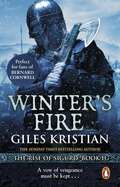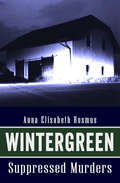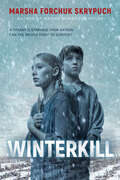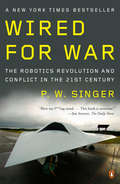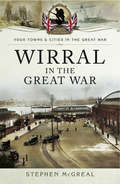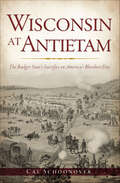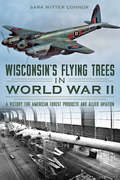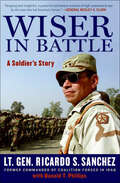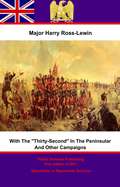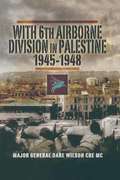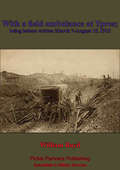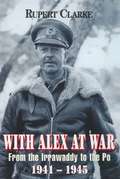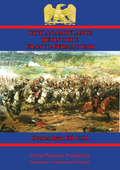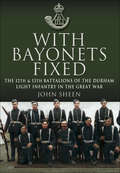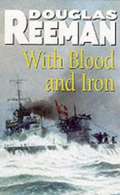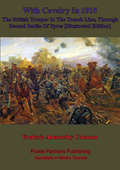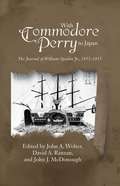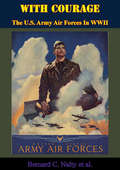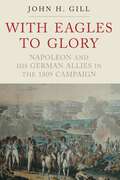- Table View
- List View
Winter's Fire: (The Rise of Sigurd 2): An atmospheric and adrenalin-fuelled Viking saga from bestselling author Giles Kristian (Sigurd #2)
by Giles KristianA thrilling and breathtaking Viking saga of betrayal, bloodshed and brotherhood from the Sunday Times bestselling author of Lancelot, Giles Kristian. Perfect for fans of Bernard Cornwell and Games of Thrones."Nobody writes this type of swaggering historical fiction better than Kristian" -- THE TIMES"A belter of a novel...perfect for fans of historical fiction and fantasy alike, from Cornwell to Abercrombie" -- BEN KANE"Combines gritty, brutal history with the lyrical essence of men as war...written with a panache that made the pages fly by. More!" -- ANTHONY RICHES"I love a good Viking romp and these are really good!" -- ***** Reader review"Giles Kristian certainly knows how to spin a yarn." -- ***** Reader review***********************************A VOW OF VENGEANCE MUST BE KEPT...Norway AD 785. Sigurd Haraldarson has proved himself a great warrior . . . and a dangerous enemy.And yet the oath-breaker King Gorm, who betrayed Sigurd's father, still lives. The sacred vow to avenge his family burns in Sigurd's veins, but he must be patient and bide his time as he knows that he and his band of warriors are not yet strong enough to confront the treacherous king. They need silver; they need more fighters to rally to the young Viking's banner; they need to win fame upon the battlefield.And so the fellowship venture to Sweden, to fight as mercenaries. And it is there - in the face of betrayal and bloodshed, on a journey that will take him all too close to the halls of Valhalla - that Sigurd's destiny will be forged...The Vikings return in this thrilling, thunderous sequel to Giles Kristian's bestselling God of Vengeance. Sigurd's adventures continue in Wing's of the Storm.
Wintergreen: Suppressed Murders
by Anna Elisabeth RosmusFollowing her acclaimed memoirs Against the Stream and Out of Passau, Anna Rosmus revisits the crimes perpetrated in her German hometown during the Second World WarPassau, a small Bavarian city situated along the border with Austria, had gone decades without acknowledging the roles—however small or large—its citizenry played in the atrocities of World War II. When Anna Rosmus attempted to rectify this oversight, she was met with praise from everywhere but Passau itself, where threats and vitriol from the local population eventually led her to emigrate from Germany to the United States. In Wintergreen, Rosmus writes of the prisoners of war and forced laborers, the Jews and other Eastern Europeans who lost their lives in Passau to the Nazi regime, and whose graves were hastily consigned to the cheapest plot of land in town.Deftly researched and powerfully written, Wintergreen is a tragic history of the atrocities committed in and around Passau, a searing rebuke of those who seek to suppress them, and a moving tribute to the victims of the Holocaust and the importance of keeping their memory alive.
Winterkill
by Marsha Forchuk SkrypuchFrom acclaimed author Marsha Forchuk Skrypuch, this incredibly gripping and timely story set during the Holodomor in 1930s Ukraine introduces young readers to a pivotal moment in history-- and how it relates to the events of today. Nyl is just trying to stay alive. Ever since the Soviet dictator, Stalin, started to take control of farms like the one Nyl's family lives on, there is less and less food to go around. On top of bad harvests and a harsh winter, conditions worsen until it's clear the lack of food is not just chance... but a murderous plan leading all the way to Stalin.Alice has recently arrived from Canada with her father, who is here to work for the Soviets... until Alice realizes that the people suffering the most are all ethnically Ukrainian, like Nyl. Something is very wrong, and Alice is determined to help.Desperate, Nyl and Alice come up with an audacious plan that could save both of them -- and their community. But can they survive long enough to succeed?Known as the Holodomor, or death by starvation, Ukraine's Famine-Genocide in the 1930s was deliberately caused by the Soviets to erase the Ukrainian people and culture. Marsha Forchuk Skrypuch brings this deeply resonant, and remarkably timely, historical world to life in a story about unity, perseverance, and a people's determination to overcome.
Wired for War
by P. W. Singer"riveting and comprehensive, encompassing every aspect of the rise of military robotics." --Financial Times In Wired for War, P. W. Singer explores the greatest revolution in military affairs since the atom bomb: the dawn of robotic warfare. We are on the cusp of a massive shift in military technology that threatens to make real the stuff of I, Robot and The Terminator. Blending historical evidence with interviews of an amazing cast of characters, Singer shows how technology is changing not just how wars are fought, but also the politics, economics, laws, and the ethics that surround war itself. Traveling from the battlefields of Iraq and Afghanistan to modern-day "skunk works" in the midst of suburbia, Wired for War will tantalize a wide readership, from military buffs to policy wonks to gearheads.
Wired for War
by P. W. SingerIn Wired for War, P. W. Singer explores the greatest revolution in military affairs since the atom bomb: the dawn of robotic warfare. We are on the cusp of a massive shift in military technology that threatens to make real the stuff of I, Robot and The Terminator. Blending historical evidence with interviews of an amazing cast of characters, Singer shows how technology is changing not just how wars are fought, but also the politics, economics, laws, and the ethics that surround war itself. Travelling from the battlefields of Iraq and Afghanistan to modern-day "skunk works" in the midst of suburbia, Wired for War will tantalise a wide readership, from military buffs to policy wonks to gearheads.
Wired for War: The Robotics Revolution And Conflict In The Twenty-First Century
by P. W. SingerA military expert reveals how science fiction is fast becoming reality on the battlefield, changing not just how wars are fought, but also the politics, economics, laws, and ethics that surround war itself P. W. Singer's previous two books foretold the rise of private military contractors and the advent of child soldiers- predictions that proved all too accurate. Now, he explores the greatest revolution in military affairs since the atom bomb-the advent of robotic warfare.We are just beginning to see a massive shift in military technology that threatens to make the stuff of I,Robot and the Terminator all too real. More than 7,000 robotic systems are now in Iraq. Pilots in Nevada are remotely killing terrorists in Afghanistan. Scientists are debating just how smart-and how lethal-to make their current robotic prototypes. And many of the most renowned science fiction authors are secretly consulting for the Pentagon on the next generation.Blending historic evidence with interviews from the field, Singer vividly shows that as these technologies multiply, they will have profound effects on the front lines as well as on the politics back home. Moving humans off the battlefield makes wars easier to start, but more complex to fight. Replacing men with machines may save some lives, but will lower the morale and psychological barriers to killing. The 'warrior ethos,' which has long defined soldiers' identity, will erode, as will the laws of war that have governed military conflict for generations.Paradoxically, these new technologies will also bring war to our doorstep. As other nations and even terrorist organizations start to build or buy their own robotic weapons, the robot revolution could undermine America's military preeminence.
Wirral in the Great War (Your Towns & Cities in the Great War)
by Stephen McGrealOn 4 August 1914 Britain declared war on Germany. Originally perceived as a short campaign to curtail Germanic imperialism, it developed into a four-year long war of attrition. The Great War is justifiably associated with the horrors of trench warfare and the death of a generation but history has overlooked the home fronts' colossal contribution to victory.On the outbreak of war thousands of troops arrived in Wirral to defend the coast from invasion and guard the docks and shipyards under the watchful eyes of the gunners of the Bidston Hill artillery batteries. The transition to a military garrison also led to the conversion of schools to military hospitals, predominately financed by the community. Thousands of wounded service men arriving at Woodside station were dispersed and administered to by a plethora of military or auxiliary hospitals. Voluntary organizations also procured funds for ambulances and comforts for those at the front. At the beginning of hostilities, the Government swiftly introduced draconian regulations to restrict liberty, particularly for those of foreign extraction. Following the 1915 sinking of the Lusitania, the xenophobia vented itself in Wallasey and Birkenhead where riots resulted in the destruction of German owned business premises. The resentment was further fueled by the German submarines attempt to destroy the British merchant fleet and starve Britain into submission they almost succeeded. As vital cargoes plunged to the sea bed, food became the latest rationed commodity; consequently unused tracts of Wirral land were turned over to food production and German prisoners of war helped clear the river Birkett. The local shipyards and factories came under the control of the Ministry of Munitions and unlikely companies were involved in the national preoccupation of producing artillery shells. Following the 1916 introduction of compulsory military service, female workers increasingly replaced the men thereby making undreamed of advances in female emancipation. Also involved in the war effort were school children who collected food for wounded soldiers, boy scouts patrolled the coastline, 'sister Susie famously sewed shirts for soldiers' and a Dad's Army was established to repel invaders. Their activities and others are generally overlooked by twentieth century chroniclers.This is the fascinating, but forgotten story of how Wirral provided the sinews for war, and made a significant contribution to the comprehensive defeat of Germany.
Wisconsin Army National Guard (Images of America)
by Eric J. KillenImages of America: Wisconsin Army National Guard is a photographic history containing more than 200 images paired with a descriptive narrative that follows the illustrious story of more than 150 years of wartime service. The book highlights little-known facts about the leaders, soldiers, and units that shaped Wisconsin's military history. It begins with the Civil War legends of Old Abe and the Iron Brigade and continues through the transformational years of the National Guard during the Spanish-American War and Mexican border crisis of the 1910s. It chronicles the unbelievable sacrifices of the 32nd Red Arrow Division during both world wars and recounts the role played by Wisconsin units in the more recent War on Terror. Both historians and general readers of history will value this guide as an enjoyable and enlightening resource.
Wisconsin at Antietam: The Badger State’s Sacrifice on America’s Bloodiest Day (Civil War Series)
by Cal SchoonoverThe Battle of Antietam was the bloodiest day in American history, and Wisconsin played a vital role. The Second, Sixth and Seventh Wisconsin Regiments served in the Iron Brigade, one of the most respected infantries in the Federal army, and fighting by their side in Maryland was the Third Wisconsin. The mettle of the Badger State was sorely tested and proven on South Mountain and on the bloody Miller's Cornfield. The Third alone lost more than half its men to death or injury, and the Iron Brigade, too, suffered extraordinary losses. Yet Wisconsin's sacrifices at Antietam rebuffed the Confederate incursion into Northern territory and enabled the Emancipation Proclamation. Civil War historian Cal Schoonover sheds new light on the exploits of Wisconsin soldiers in this turning point to secure the Union.
Wisconsin's Flying Trees in World War II: A Victory for American Forest Products and Allied Aviation
by Sara Witter ConnorA look at how the Wisconsin lumber industry and the U.S. Forest Products Laboratory contributed to Allied efforts in World War II.Wisconsin’s trees heard “Timber” during World War II, as the forest products industry of the Badger State played a key role in the Allied aerial campaign. It was Wisconsin that provided the material for the De Havilland Mosquito, known as the “Timber Terror,” while the CG-4A battle-ready gliders, cloaked in stealthy silence, carried the 82nd and 101st Airborne into fierce fighting throughout Europe and the Pacific. Author Sara Witter Connor follows a forgotten thread of the American war effort, celebrating the factory workers, lumberjacks, pilots, and innovative thinkers of the U.S. Forest Products Laboratory who helped win a world war with paper, wood, and glue.
Wiser in Battle: A Soldier's Story
by Donald T. Phillips Ricardo S. SanchezAmidst all of the criticisms of America's war in Iraq, one essential voice has remained silent . . . until now. In his groundbreaking new memoir, Wiser in Battle, LTG (Ret) Ricardo S. Sanchez, former Commander of Coalition Forces in Iraq, reports back from the front lines of the global War on Terror to provide a comprehensive and chilling exploration of America's historic military and foreign policy blunder.
With "The Thirty-Second" In The Peninsular And Other Campaigns
by Prof. John Henry Wardell Major Harry Ross-LewinThis ebook is purpose built and is proof-read and re-type set from the original to provide an outstanding experience of reflowing text for an ebook reader. Although the 32nd Regiment was primarily recruited in and around Cornwall, leading to many scraps with the Navy for manpower, in its ranks during the Napoleonic wars the two Irish brothers of the Ross-Lewin family fought, the elder brother Harry left an exciting and vibrant account of his campaigning. His adventures took him from the West Indies, engagements with rebel Irishmen, Copenhagen, even before his arrival in the Peninsular to start his campaigns under Wellington in 1808. His first major trial under fire begins at Rolica and Vimiero, before he and his brave men are sent off to the pestilent climes of Walcheren. Returning to the Spain once again he is heavily engaged during the battle of Salamanca, during which he is wounded, once mended his service takes him onward to France via a number of battles at Bayonne, Orthez and Toulouse. During his campaigning he suffers the loss of his brother Edward and writes touchingly of his bravery before he fell. His account of the Waterloo campaign is amongst the best that survive, accurate and vividly written, he was lucky to survive the culminating battle as his regiment was one of the most severely depleted. Major Ross-Lewin originally wrote three volumes of his memoirs of his time in the British army under the title of "The Life of a Soldier, by a Field Officer" in three volumes; this edition has been expertly trimmed the then reader of Modern History at Trinity College, Dublin. This work shares the tone of his countryman William Grattan's memoirs, with a wry view of the antics of his soldiers, an eye for the details of what passed before him, interspersed with battle vignettes that convey the fire and confusion of battle. Text taken, whole and complete from the 1904 edition, Hidges and Figgis & Co, Dublin. Original -368 pages Author - Major Harry Ross-Lewin (1781-1872) Editor - Prof. John Henry Wardell (1898- Aug 1957) Linked TOC
With 6th Airborne Division in Palestine, 1945–1948
by Major General Dare WilsonThe 6th Airborne Division was a major element of the British Security Force in Palestine between September, 1945 and May 1948. Faced with the unenviable task of upholding the law in a lawless country, the individual British soldier had to face continual opposition from a hostile Jewish community. This story is described by General Wilson, then a Major, who served with the division during this period. The mission of British forces was simply "to keep the peace". To achieve this goal, the 6th Airborne Division conducted a variety of counter-insurgency operations in both urban and rural environments. These operations were designed to locate illegal arms caches, limit Jewish-Arab violence and capture dissidents who had attacked British positions. The destruction of the King David Hotel, the most famous terrorist attack of the Mandate period, is treated in great detail. With 6th Airborne Division in Palestine 1945 - 48 is a tribute to the British soldier. It is also an excellent case study in unconventional warfare. It will be of great interest to any student of the intricate problem that Palestine presents.
With A Field Ambulance At Ypres, Being Letters Written March 7-August 15, 1915: Being Letters Written March 7, To August 15, 1915 (1916)
by William BoydAs an Allied soldier, the Ypres salient was a hellish tongue of land to serve in during the First World War. Overlooked by German forces, surrounded on three sides by the enemies' guns, with little or no protection from the land features, it became a symbol of the stubborn resistance of the Allied soldier in the thin grim trenches. The troops faced shells, bullets, mortars, grenades and poison on a daily basis, whilst only just behind the frontline the Royal Army Medical Corps struggled to deal with the influx of wounded.Captain Boyd, as he then was, recounts his experiences in the bloody, cramped and over-worked hospitals as he attempted to save lives so brutally injured by the war. The Author went on to have an illustrious career as an internationally famed pathologist in Canada.Author -William Boyd, MB, ChB, MD, MRCP.Text taken, whole and complete, from the edition published in New York, George H. Doran company 1916.Original Page Count - 110 pages.
With A Heart Full of Love: Clara Taylor's Letters from Russia 1917–1919 Volume 2
by Katrina Maloney & Patricia M. MaloneyFrom the fall of 1918 to summer 1919, six YWCA women are attached to the North Russia Expeditionary Forces, an international military mission posted in the city of Arkhangelsk, North Russia. With this change, Clara Taylor’s second year working for the YWCA in Russia turns out to be vastly different from her previous year in Moscow. No longer teaching home economics or surveying factory conditions, Clara now finds herself dancing with soldiers at parties, then learning of their deaths in action the next day; reading to ill soldiers in the hospital; and serving hot coffee to ragtag men on the front lines of the Vologda railroad front in the bitter Russian winter. Throughout, she remains strong, courageous, and dedicated to her ideals of service. Even her own hospitalization for appendicitis does not stop her from supporting others in an untenable situation. Able to let loose about her own political views in these letters, Clara writes scathing commentary about the ineptitude of the military command. She also writes of the frozen landscape, the astounding beauty of the northern lights, homesickness, the strength of the Russian people, and, finally, the overwhelming joy of returning home to her family.
With Alex at War: From the Irrawaddy to the Po, 1941–1945
by Rupert ClarkeAs a young Irish Guards Officer in 1940, Sir Rupert Clarke became ADC to Alexander, already a distinguished officer thanks to his intelligence and courage.Alex had been the last senior officer to leave the Dunkirk beaches. For the next 4 years, the author was Alex's constant companion. In this book he shares the excitement and experiences of those years. Alex had Churchill's unwavering confidence, protected Montgomery like no other could, and was respected and loved by those who served him
With An Ambulance During The Franco-German War [Illustrated Edition]: Personal Experiences And Adventures With Both Armies, 1870-1871
by Dr Charles Edward Ryan[Illustrated with portrait of the Author and additional maps]"A classic of 19th century war reportage by an Irish surgeon who led an ambulance unit on both sides of the Franco-Prussian War. Includes eye witness descriptions of the debacle at Sedan and the gruelling siege of Paris.Charles Ryan was an Irish surgeon from Tipperary who served with a horse-drawn Anglo-American ambulance unit in the latter stages of the 1870-71 Franco-Prussian War. This vivid account of his experiences is a fascinating glimpse of the war and the siege of Paris which concluded it from a civilian whose work involved him at the sharp end. The book opens by describing the disastrous French debacle at Sedan where an army, commanded by the Emperor Napoleon III in person, was trapped and crushed by the artillery of surrounding Prussian forces, despite heroic charges by the French cavalry. Later in the war, Ryan's unit saw the war at close quarters on both sides of the lines - inside besieged Paris; and at the Prussian HQ at Versailles. Because this account, compiled from Ryan's own recollections and his letters home, was not originally written for publication, it has a freshness and an immediacy that make it a classic of 19th century humane war reportage."-N&M Print Version.
With Bayonets Fixed: The 12th & 13th Battalions of the Durham Light Infantry in the Great War
by John SheenIn August and September 1914 the Regimental Depot of the Durham Light Infantry at Fenham Barracks in Newcastle was overwhelmed by the number of men enlisting. Accommodation was tight so the men were formed into batches and sent off to training grounds in the south of England. Over 2,000 men were sent to Bulllswater near Woking in Surrey where they became the 12th and 13th Battalions of the DLI serving in 68 Brigade of the 23rd Division, commanded by Lieutenant General Sir James Babington KCB KCMG. The Division never failed to take an objective between 1915 and 1918.After initial training around Aldershot and Ashford, in May they embarked for France on 25 August 1915. In November Private Thomas Kenny, of the 13th DLI, a miner from Wingate, County Durham, won the Victoria Cross rescuing his wounded officer. In the summer of 1916 they joined the fighting on the Somme and took part in the capture of Contalmaison on 10 July. In October the two battalions took part in the capture of Le Sars before being sent north to the Ypres Salient. In Flanders they took part in the Battle of Messines and the 3rd Battle of Ypres. In November 1917 the 23rd Division was ordered to the Italian Front. The 12th and 13th Battalions were initially deployed on the Montello before moving into the mountainous region of the Asiago Plateau. They were attacked by the Austrians on 15 June 1918, however, the only enemy soldiers that entered the Durhams' trenches did so as prisoners, brought in by men of the two battalions. The 13th DLI was ordered back to France in September 1918 where it took part in the advance to victory; the battalion suffered many casualties in the last six weeks of the war. The 12th DLI remained in Italy and took part in the crossing of the River Piave in October 1918 and the Battle of Vittorio Veneto that led to the end of the war in Italy.The book uses unpublished memoirs and diaries along with letters from officers and men of both battalions. Using the soldiers personal documents this book reveals many of the tragic stories that led to unnecessary loss of life. Lists of gallantry awards and nominal rolls of officers of both battalions are included.
With Blood and Iron
by Douglas ReemanIt's January 1944. On the vast grey waters of the Atlantic the balance of power has shifted. For Rudolf Steiger, ace U-boat commander, there is a new sense of urgency. Dedicated, ruthless, fanatical, he has become a legend in his own time, a symbol of Germany's greatness. But now, he faces a new and deadly enemy.
With British Snipers to the Reich
by Capt. C. ShoreFirst published in 1948, this book is a practical guide to the sniper’s art in World War II. Captain Shore’s enthusiasm for firearms and especially for rifles led him to take every possible opportunity to try out different weapons, ammunition and methods of shooting. His interest was combined with sound common sense, and he would never countenance a rumour about a particular weapon or incident unless he was able to confirm it for himself.As a result everything in this book is based on his personal experience. In World War II Captain Shore took part in the British landings at D-Day, and fought in Normandy and northern Europe. He came across many different weapons in varying condition, some of the worst being those used by the Dutch and Belgian resistance fighters. He was keen to learn from experienced snipers and then to train others, and he became an officer sniping instructor at the British Army of the Rhine Training Centre.He shares a wealth of first-hand knowledge of different rifles, pistols, machine guns, ammunition, telescopes, binoculars and all the equipment a sniper should carry. This is not only an account of sniping in World War II but also a guide to all aspects of sniping based on personal knowledge and experience in training and battle. Illustrated heavily with photos, pictures and other illustrations of snipers, their weapons and their tactics.
With Cavalry In 1915, The British Trooper In The Trench Line, Through Second Battle Of Ypres [Illustrated Edition]
by Frederic Abernethy ColemanFrederic Coleman returns to the front with the British Army in 1915 after his adventures in 1914, as recounted in his first reminiscences "From Mons to Ypres with General French". Once again attached to the British cavalry, grand movements had ceased and the positional war of attrition, artillery and trenches would dominate from then to the end of the war. 1915 would see much hard fighting and the cavalry divisions would often be pressed into service in the trenches alongside the infantry. The early months of 1915 were a period of relative quiet, which allowed the author to tour and recount the devastated scenery of Ypres, St. Eloi and all along the line; he also records the effects of war on the civilian French and Belgian populations as he tours along in his car. However, as the year goes on, the Spring would see the second battle of Ypres and the advent of the use of poison gas. Hard pressed all along the line, Coleman paints vivid picture of the desperate measures undertaken by the British to hold on at all costs.An excellent First World War One memoir.Author -- Frederic Abernethy Coleman 1876-1931Text taken, whole and complete, from the edition published in London: S. Low, Marston & co., limited, 1916.Original Page Count - xvi and 302 pages.Illustrations - numerous illustrations throughout.
With Commodore Perry to Japan
by John J. Mcdonough John A. Wolter David A RanzanWith Commodore Perry to Japan offers a personable account of Commodore Perry's expedition to Japan through the eyes of a sixteen-year-old purser's clerk of the Mississippi. The National Historic Publications & Records Commission (NHPRC) -endorsed documentary edition provides excellent coverage of both the political mission of the Perry expedition - the opening of relations with Japan - and of the social history of a naval warship as well. Speiden kept entries on a regular basis, although not always daily, and he filled more than three hundred, closely written pages dating from 9 March 1852 to 16 February 1855. Adding significantly to the interest of Speiden's account are nearly seventy illustrations ranging from hand drawn, pen-and-ink scenes of everyday life sketched by Speiden and other members of the crew to exquisitely colored and detailed pith paintings by Chinese artists.Before its departure for Japan, the Mississippi made calls at several ports on the East Coast and also devoted more than a month to investigating problems involving fishing rights in Canadian waters. On 24 November 1852, following a visit from President Millard Fillmore, the Mississippi headed across the Atlantic Ocean. After a brief stop at Madeira and a visit ashore at St. Helena, where Napoleon's gravesite was described and sketched, the Mississippi headed for the Cape of Good Hope. Cape Town was reached on 24 January 1853, and after a stay of ten days, where Speiden visited the countryside remarking on the turmoil between the English and the Xhosa tribes, the voyage was continued across the Indian Ocean by way of Mauritius, Ceylon, Malacca, and Singapore to Macao and Hong Kong.On 31 March 1854, Speiden was among the few select officers in the landing party on the great occasion, the signing of the treaty between the United States and Japan. As a young purser's clerk Speiden played only a minor role in these historic undertakings but he was enthusiastic and alert, and made the most of his situation and the opportunities it presented. A return visit, occupying most of June, was made to Shimoda before sailing for Hong Kong by way of the Loo Choo Islands. On 12 September 1854, Speiden and the Mississippi went to sea the following day, and the remainder of his journal, filling thirty-two pages, recounts visits to Honolulu, San Francisco (including a trip to the gold fields near Sacramento), and Valparaiso.
With Courage: The U.S. Army Air Forces In WWII
by Bernard C. Nalty Alfred M. BeckThe four years between 1941 and 1945 were years in which the nation raised and trained an air armada and committed it to operations on a scale unknown to that time. With Courage: The U.S. Army Air Forces in World War II retells the story of sacrifice, valor, and achievements in air campaigns against tough determined adversaries. It describes the development of a uniquely American doctrine for the application of air power against an opponent's key industries and centers of national life, a doctrine whose legacy today is the Global Reach-Global Power strategic planning framework of the modern U.S. Air Force. The narrative integrates aspects of strategic intelligence, logistics, technology, and leadership to offer a full yet concise account of the contributions of American air power to victory in that war.--Print Ed.
With Eagles to Glory: Napoleon and his German Allies in the 1809 Campaign
by John H. GillWhen Napoleon's Grand Armee went to war against the might of the Habsburg empire in 1809, its forces included more than 100,000 allied German troops. From his earliest imperial campaigns, these troops provided played a key role as Napoleon swept from victory to victory and in 1809 their fighting abilities were crucial to the campaign. With Napoleon's French troops depleted and debilitated after the long struggle in the Spanish War, the German troops for the first time played a major combat role in the centre of the battle line.Aiming at a union of German states under French protection to replace the decrepit Holy Roman Empire, Napoleon sought to expand French influence in central Germany at the expense of the Austrian and Prussian monarchies, ensuring Frances own security. The campaign Napoleon waged in 1809 was his career watershed. He suffered his first reverse at Aspern. Victory was achieved at Wagram was not the knock-out blow he had envisaged.In this epic work, John Gill presents an unprecedented and comprehensive study of this year of glory for the German soldiers fighting for Napoleon, When combat opened they were in the thick of the action, fighting within French divisions and often without any French support at all. They demonstrated tremendous skill, courage and loyalty.
With Fidel: A Portrait of Castro and Cuba
by Fidel Castro Frank Mankiewicz Kirby JonesThis book is the result of three trips to Cuba in 1974 and 1975 by Frank Mankiewicz and Kirby Jones. The first trip lasted from June 29 to July 21, 1974; the second from September 28 to October 6, 1974; and the third from January 24 to February 4, 1975. The main purpose of the trips was to conduct an in-depth interview with Cuban Prime Minister Fidel Castro for American television. Over the course of four days and nights from July 18 to July 21, we spent more than eleven hours in formal interview with Castro and another twelve hours in informal conversation and traveling with him by jeep throughout the Havana area. All conversations with Castro were conducted in Spanish. During the second trip, there were an additional two hours of filmed interview, and over six hours were spent meeting informally with Castro.
